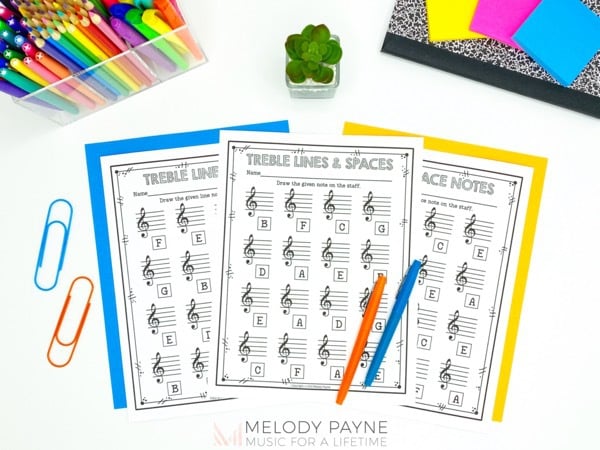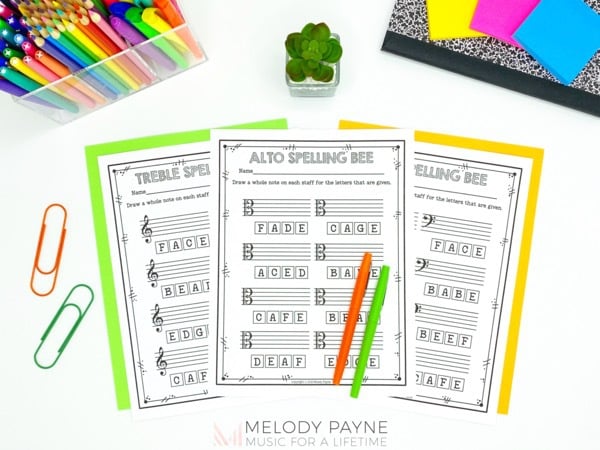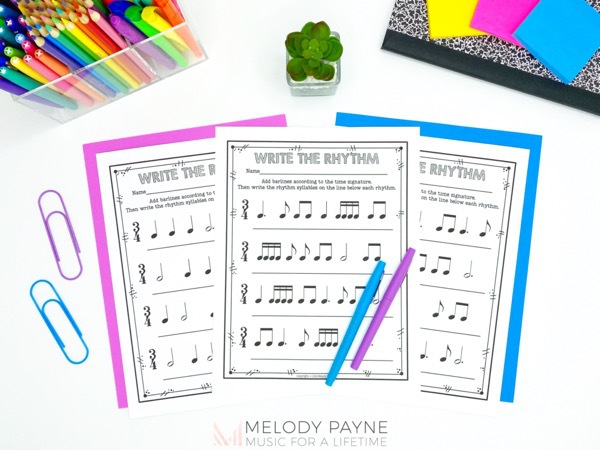Save Time With Over 200 Print-and-Go Music Theory Worksheets!
This post may contain affiliate links. If you purchase something through an affiliate link, I will receive a small commission at no cost to you. For more information, read the disclosure statement here.

What music teacher wouldn’t like a little more time to enjoy summer? Less time prepping for fall music classes = more time for yourself!
For your beginners and progressing students, here are 209 music theory worksheets (plus answer keys!) that come in an instant download.
They are already organized in a zip file into 19 logical categories.
Whether you teach private instrumental lessons, group lessons in your own studio, or music classes in the school system, there is something here for you.
All you have to do is print and distribute the worksheets to your students — and watch the learning begin!
The problem with many current theory books is that the pages are crowded.
When there is too much theory to do on one page, students often feel overwhelmed from the start.
However, what is immediately attractive about these music theory worksheets is that there is only one concept per page.
Furthermore, each concept is divided into small tasks.
There is also a perfect amount of “white space” on each page, and the print size is fairly large.
For all these reasons, students will look at these pages and get the feeling that the activities are easy.
And when pages look engaging and uncomplicated, students more readily tackle them, don’t they?
If you’re a visual learner, there is an in-depth preview video of these music theory worksheets just for you at the bottom of this article.
Music Theory Worksheets Part 1: A Solid Beginning!
Higher, Lower, Same: The first packet of worksheets in this comprehensive bundle of music theory worksheets comprises a total of nine pages that are sequential in level of difficulty and use the treble, bass, and alto clefs equally. First, the student sees sets of two notes at a time on the treble staff.
Each set of two notes has its own clef and its own little staff, so students can truly focus on just two notes at a time. They write “H” if the notes move higher, “L” if the notes move lower, or “S” if the two notes are the same.
The next two pages consist of the same activity using the bass clef and alto clef instead.
Subsequently, there are pages in which the student is to trace two notes at a time, then circle the note that is lower.
On the next pages, the students do the same but circle the note that is higher.
With only nine mini-tasks per page, the overall impression given is one of uncluttered, easy music theory.

Lines and Spaces: This section consists of 15 sequential pages with an even distribution of treble, bass, and alto clef worksheets.
As before, there are nine mini-staves per page. On each staff, there is only one note. Students simply write “L” if it’s a line note, or “S” if the note is a space note.
On subsequent pages, students name space notes in one clef only, and then name line notes in one clef only.
They write the “saying” (e.g. FACE, Every Good Boy Deserves Fudge, etc.) at the top of the page.
This serves as a good reminder!
Finally, students trace the space notes and then trace the line notes, writing the note name in the box below each note.

Note-Naming Practice: Sixteen pages of vital theory await your eager students! There are three each of treble clef, bass clef, and alto clef pages to complete.
Some of them contain just line notes, some have just space notes, and some have both lines and spaces.
Then, there are pages designed specifically for piano students.
Do your students need note-naming practice in C, Middle C, or G Position? Seven additional worksheets await them.
All of these worksheets have 16 notes to label, each one having its own clef and its own little staff so students can focus on labeling one note at a time.

Draw Notes on the Staff: Once students can name the notes, it’s time to draw them!
There are nine pages to practice this skill on, three pages for each clef. The worksheets follow a logical sequence.
First, students draw line notes on the treble staff. On the next page, they draw only space notes, and on the third page, they draw both line and space notes. The same sequence is repeated for the bass staff and the alto staff.
Again, there are 16 notes to draw per page, always well spread out.
This gives the impression that there’s not too much “work” involved.
And we all know that student impressions are important, especially when being asked to complete music theory worksheets!

Music Theory Worksheets Part 3: Puzzles and Games!
Musical Spelling Bee: Here we have 12 pages of fun, each with a slightly different focus. On six of the pages, students identify notes on the staff, thus spelling the given words. On the other six pages, they draw whole notes to spell the words.
There are three-letter words to spell in each of the three clefs, then four-letter words in each clef.
Each page is limited to just one of the aforementioned tasks. There is always a clef at the start of each “word” to remind students of which clef they are in.
Determining the “words” is kind of like a puzzle or mystery for students to solve, and in my experience, they love this type of activity! The music theory worksheets in this section don’t even feel like worksheets!
(If you have students who love musical spelling, check out Ten Tips for Using the Springtime Musical Spelling Bee Game at Piano Lessons)


Word Search Puzzles: Choir and band teachers take note! Students are familiar with this type of puzzle, and will surely enjoy completing these nine. There’s a puzzle for each of the following categories:
- Music Symbols
- Dynamics
- Notes & Rests
- Famous Composers
- Brass Instruments
- Percussion Instruments
- Wind Instruments
- Stringed Instruments
- Folk Instruments
Not only are the symbols at the top of each page depicted, but also there are clear, helpful drawings of the musical instruments.

Crossword Puzzles: There are six with word banks, plus the same six puzzles without the word banks. The categories are:
- Tempo Terms
- Dynamics
- Instruments of China
- Instruments of Africa
- Classroom Instruments
- Folk Instruments of America
At the top of puzzles three – six, there are very clear drawings of each instrument. If you’re a music teacher who teaches world music, your students will love completing these!
The American folk instrument puzzle was the most intriguing to me. I’ve heard of or seen the banjo, autoharp, kazoo, and spoons, but I’m unfamiliar with the dulcimer, jug, washtub bass, washboard, concertina, and dobro.
Most of the puzzles have ten words to solve; only the Chinese instruments puzzle has eight words.

Music Theory Worksheets Part 4: Rhythms & Symbols
Write the Rhythm: In these six pages, each containing four lines of rhythms, students add the missing bar lines.
They also write the rhythm syllables or counts on the line below each rhythm (1, 2, 3, 4, Ta-Ta-Ta-Ta or whatever system you use). Only two time signatures are employed: 3/4 and 4/4 time.
There are two Level One pages, consisting of quarter notes, half notes, and dotted half notes. Then there are two Level Two pages, with the same rhythms as Level One plus dotted quarter notes and eighth notes.
Finally, there are two Level Three pages, with all the rhythms of the previous levels plus sixteenth notes.

Time Signatures: These six pages also comprise three levels. The note values and time signatures correspond to those described above.
However for these activities, students have to determine the time signature, add the missing bar lines, and draw a double bar line.
With only four lines of rhythms per page, the notes are big and there is lots of white space, adding to the overall “easiness factor”!

Drawing Symbols: These five pages, each containing nine large squares, require just one task: draw various music symbols, one in each square. There is plenty of room to draw such things as dynamics, parts of the grand staff, notes and rests, sharps, flats, naturals, etc. This is valuable practice!

Identifying Symbols: On these four pages, students simply write the name of each musical symbol on the line provided. There are nine symbols per page, each of them quite large, so the task looks easy! The musical symbols are the same as described above.

Music Theory Worksheets Part 5: Piano Keys, Pentascales, & Chords
Piano Keys: These eight sequential pages contain keyboard diagrams of varying lengths. Each page requires a different task.
For instance, on the first page, students draw a line from each piano key with an arrow on it to the correct letter; A, B, C, D, E, F, & G are provided. Then, students identify each piano key that has a star on it. They are all white keys.
On the second page, long keyboard diagrams are provided. Students write the letter name on every other piano key. Then in the next two diagrams, students write the letter name on every key marked with an arrow (random white keys).
Each subsequent page is a little more complex. By the time students reach the last few pages, they are drawing a line from the provided letter (sometimes with sharps & flats!) to the correct piano key. Then they draw the note on the staff.

Five-Note Scales: Piano teachers who teach pentascales will appreciate having these six sequential worksheets to give to students as a good reinforcement of the notes.
Seven different major scales and seven different minor scales are represented here.
As always, there is only one task per page. One activity is matching — match the picture of each five-note scale to its name.
Another activity is identifying and labelling — write an X on each piano key of the given major or minor five-note scale. Then write the letters of that scale in the boxes, including accidentals.

Chords: Here are 14 sequential music theory worksheets featuring a multitude of major and minor chords. There is such a variety of activities for students to do! Students identify the notes of chords on keyboard diagrams, on the staff, or both. There are seven tasks per page and as always, the instructions are very clear.

These worksheets will give you an introduction to scales and chords, but if you need even more hands-on learning teaching scales, and chords, check out:
- Teaching Scales, Chords, And Arpeggios Using The Superstar Scales Piano Technique Book
- 5 Reasons to Use Junior Superstar Scales with Young Beginners
- Teaching Beginning Piano Technique To Young Piano Students
More Music Theory Worksheets? Indeed!
Musical Math: Ready for ten pages of musical addition, subtraction, and multiplication? Math isn’t limited to math class anymore! In each of these pages, an example is given at the top to help learners know exactly how to proceed.
Students add notes, for example, quarter note + whole note = 5, subtract notes, e.g. half note – half note = 0, or multiply, e.g. whole note X whole note = 16.
For some pages, pupils must answer the musical math problem by writing a note in the space provided instead of a number. Good thing there’s an answer key for those of us who haven’t done multiplication in awhile!
We have another whole blog post if you need ideas for using these specific worksheets. Read 7 Ways to Use Music Math Worksheets in a Variety of Music Classes.

Music Terminology: In these ten pages, there are anywhere from 12 – 15 tasks per page.
Some pages require the student to simply define the given term, e.g. treble clef, eighth rest, grand staff, forte, sharp, fermata, ritardando, and many more Italian terms.
Now the real fun can begin! The next few pages involve unscrambling some words. There are tempo words, composer names, note names, and other musical symbol words that students need to unscramble.
For some pages, learners must also draw a picture of the term or note in the box provided.

Music Symbol Coloring Worksheets: Twenty-one pages of coloring fun! Each page has a large music symbol or note to color. The instructions on each page are the same:
- Circle the correct musical term from a list of four given terms.
- Write the definition.
- Trace and draw the symbols on the staff provided.
- Color the picture.
This gives students an enjoyable review of notes, rests, symbols, Italian terms, etc.

Just for Fun Pages
Use these anytime you’d like your students to be creative. The worksheets would also be very useful if you had a substitute teacher for your music class one day.
Each of these ten pages require students to find words within a given word. The large print musical word on each page from which students must find smaller words is one with a lot of letters, such as the words articulation, accelerando, accompaniment, impressionism, etc.
After defining the term, pupils can either make a list of all the smaller words they found or create a “word cloud”. An example of this is given. This activity could be used in any music class, from elementary school to university!

Final Thoughts
Wow! This bundle of music theory worksheets really packs a punch at an affordable price. Private teachers will especially appreciate that these pages are all black & white — save on ink costs!
And if time is a consideration, think how many hours you’ll save by simply going to the category you want and printing out what you need, when you need it. Why re-invent the wheel when the work has already been done for you?
There are so many ways that these activities could be used, depending on where, how, and what age you teach.
- They could be used in group classes or private lessons when quiet time is needed.
- They could be assigned as homework.
- If you teach online, they could be sent to students via the Internet or screen shared. Click here to learn how to use these music theory worksheets on your iPad!
- You can give the student or parent the answer keys so that they can check their own work.
- Certain worksheets, such as the spelling bee pages, can be set up as a contest during a group class.
- Or you can have students do these theory worksheets in class as an assessment.
Grab these 200+, print and go, no prep, music theory worksheets today and reclaim some personal time this summer and throughout the upcoming year!
See the Music Theory Worksheets in Action!
Take a closer look at over 150 of the pages in this set of music theory worksheets and you’ll see how much value they will add to your piano studio and music classroom, and how much time and energy they will save you as you prep for lessons and classes!

Even more blog posts on music theory worksheets…
Don't miss out!
Follow on Facebook and Instagram, join the best Facebook group for piano teachers, and subscribe to the newsletter to get helpful teaching tips, resources, and tutorials delivered straight to your inbox every week.
Celeste-tina Hernandez
Celeste-tina Hernandez
Welcome!

Hi! I’m Melody Payne, a pianist and piano teacher, educational resource author, a fun-loving wife to the most wonderful and talented hubby I could ask for, and a lifelong learner who loves to share. I want to make your life as a music teacher easier by writing and sharing helpful and relevant music teaching articles, and by creating educational resources with your very own students in mind. If you are a parent who wants to enroll your child in piano lessons, I’d love for us to get started building those skills that can give your child a lifetime of musical enjoyment!

